|
| |
Back to private
aircraft
|
|
The Piper J3 Cub is one of the most widely
produced aircraft of all time. It evolved from a design of C.G.
Taylor but refined by W. Jamouneau (hence the J in the designation),
who worked for businessman William Piper. The intention was to build
a simple, cheap and reliable aircraft suitable for private owners.
It succeeded in spadefuls. Including military L-4s, more than 20,000
were built. It is a two seater, the passenger sitting behind the
pilot. Construction is very simple - a steel tube frame with canvas
covering. Most Cubs were powered by a 65hp Continental A65 engine.
Its very slow stalling speed makes it suitable for operation into
short, awkward airstrips. The original J2 Cub first flew in 1935.
Range is 240 miles at a typical cruising speed of
80mph. Maximum takeoff weight is 1,100lb. Wing span, 35 feet 3
inches; length, 22 feet 3 inches.
The top picture was taken at Kemble in July
2005. The lower picture shows a Cub in US military markings visiting
Top Farm, also in July 2005. Note the different shapes of the rear
cabin windows and the fully cowled engine in the lower picture. |
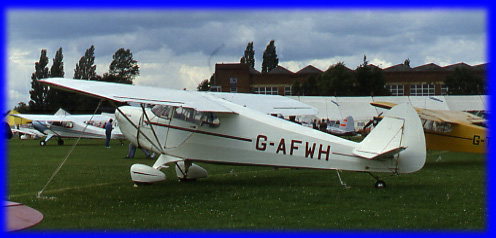 |
The Piper J4 Cub Coupe was effectively just a
normal Cub but with side by side seating. This resulted in a wider
fuselage and slightly slower cruising speed. Around 1,250 of them
were built. This one was at Cranfield in
July 1988. |
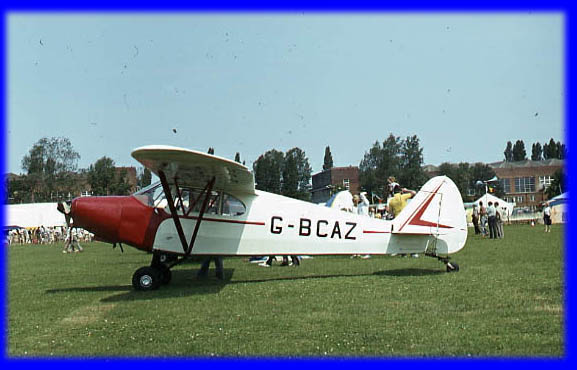 |
The Piper PA12 Super Cruiser was a further
development of the Cub, with seating for three and a more powerful
100hp Lycoming engine. Cruising speed was increased to 100mph and
range to 340 miles. Maximum take-off weight became 1,750 lb. The
wing span, at 33 feet 6 inches, is only slightly longer than the J3.
3,750 Super Cruisers were built after the end of the second world
war. This one was at Cranfield in July
1983. |
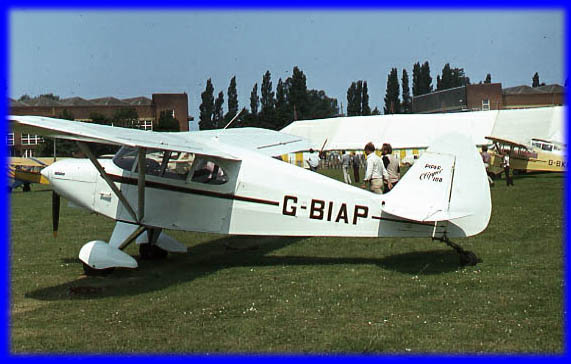 |
The Piper PA16 Clipper was a short wing (29
feet 4 inches) four seat version of the Vagabond (see below). To
lift the extra weight it was fitted with a 108hp Lycoming O-235
engine, which gave it a cruising speed of 110mph and range of over
500 miles. It first flew in 1949. Relatively few were made before
they were superseded by the PA20 Pacer (below).
This one was at Cranfield in July 1983. |
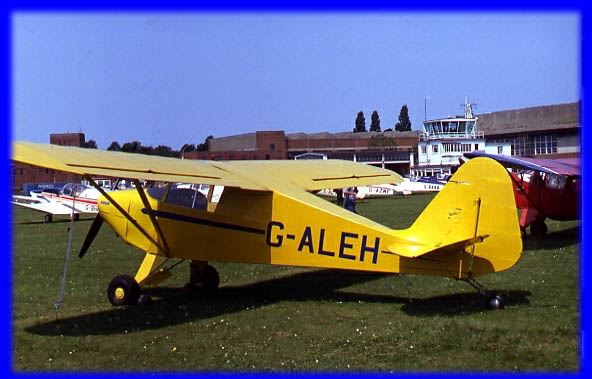 |
The Piper PA17 Vagabond was a tough little
two seater aircraft which was produced in fairly limited quantities
from 1948. It is powered by a 65hp Lycoming (PA15) or Continental
(PA17) engine. The other significant differences between the PA15
and 17 are that the PA17 has dual controls and a refined
undercarriage. Wing span is 29 feet 3 inches; length, 18 feet 8
inches; cruising speed 90mph; range 250 miles.
This one was also at Cranfield in July 1983. |
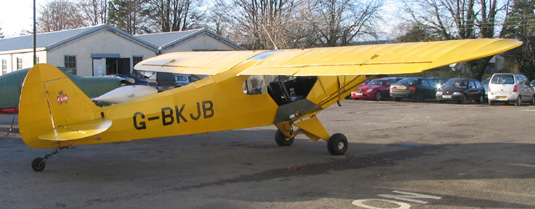 |
The Piper PA18 Super Cub is the refined
version of the long winged (35 foot 3 inch span) Cub, which first
flew in 1949 and remained in production until 1995, by which time
about 7,850 had been built. Like the J-3 being a two seater, it can
be powered by various engines ranging from 90 to 150 horsepower.
This enable sit to cruise at 115mph for a range of 460 miles. It is
hard to imagine a more delightful little machine for pottering about
in. This one was at Old Sarum in Spring
2006. |
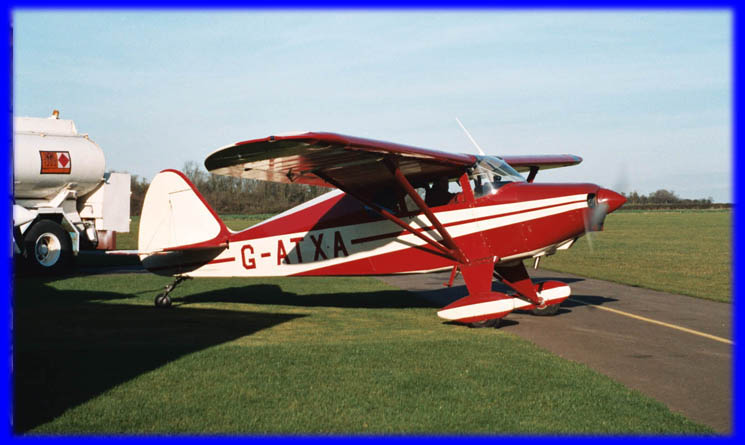 |
The Piper PA20 Pacer was a refined
development of the PA16 Clipper. First flown in 1949, it is powered
by a 125hp Lycoming O-290 engine. Main external differences from the
Clipper are that the Pacer has flaps and angled rather than rounded
glazing on the rear cabin window. Dimensions and speeds are very
similar to the Clipper. Around 1,120 were built.
This one was pictured at Top Farm in Spring 2005. |
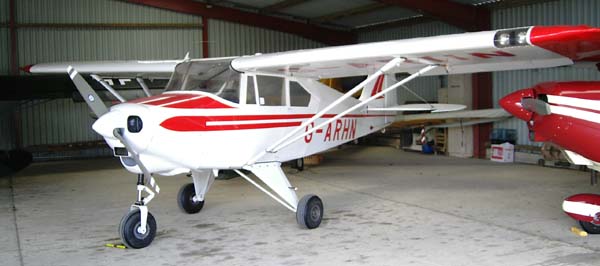 |
The Piper PA22 Tri-Pacer is basically the
same as the Pacer but with a nosewheel undercarriage. It was first
flown in 1950. Engines ranged from 108 to 160hp in the various
versions. Normal seating is for four, but the simplified PA22-108
Colt was a two seater. Maximum weight is a bit more than the Pacer
(2,000lb) and the cruising speed a bit more (130mph). About 9,500 of
all versions were built before production ceased in 1964.
This one was visiting Top Farm in Summer 2005. |
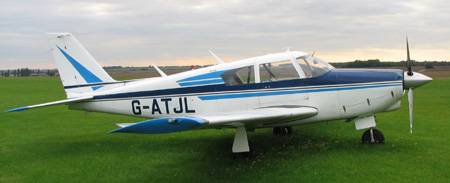
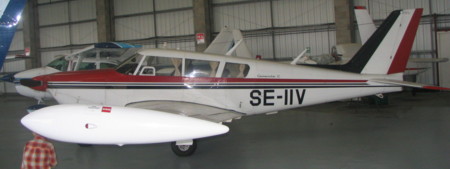 |
The Piper PA24 Comanche first flew in May
1956. It was designed (with initial advice from Al Mooney) as a
competitor to the Beech Bonanza as a luxury high performance four
seat touring aircraft. Engines ranged from 180 to 260hp (though one
variant, the PA26, had a whacking 400hp engine which gave it a
cruising speed of over 200mph, enabling the pilot to get to the
frequent refuelling stops faster. The -400 has a three bladed
propellor and a bigger tail). Around 4,700 were built, plus 150
-400s. Top: Comanche 260 was visiting
Top Farm in Spring 2005. Bottom: Gamston, November 2007. |
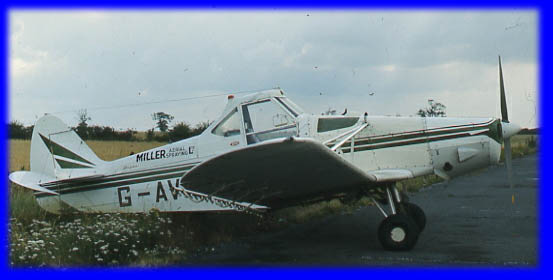 |
The Piper PA25 Pawnee is a dedicated
agricultural aircraft. A single seater, everything about it is
optimised for the task. Most of the 1,600lb payload is the massive
chemical hopper. The wide (36 feet 2 inches), high dihedral wing is
optimised for stability while spraying and good low speed handling
to allow tight turns for striped passes over the fields. Typical
spraying speed would be about 85mph. Various versions were built,
with engines ranging from 150 to 260hp. It first flew in 1957; over
5,000 were built. With wide boom sprayers on high wheeled tractors
now cheaply available, combined with the problem of drift of spray
outside the specific area, far fewer aircraft are now used for crop
spraying; but the Pawnee's characteristics are also ideally suited
to glider towing, so many have found a new lease of life in a role
for which they were never originally envisaged.
This one was at Shipdham in July 1976. |
|
|
The PA28 Cherokee is Piper's most successful
product, outselling even the ubiquitous Cub with over 30,000 having
been sold since it first flew in January 1960. It is still in
production at the time of writing (January 2006). It was designed by
John Thorp, designer of the Thorp 211 and Fletcher FU-24. The
original Cherokee 140 (top picture) had parallel chord wings of 30
feet span, and two cabin windows. The Cherokee 180 introduced the
third cabin window. Versions introduced in the mid 1970s included
the Warrior and Archer (bottom picture - the Archer in which David
had a share for a short time before the group upgraded to an Arrow,
with David and Georgina). These had a new wing spanning 35 feet,
with a tapered outer section. A heavy utility version, the Dakota,
had a 235hp engine (which some people consider rather overkill for
the airframe). All are four seaters, except for a small number of
the Cherokee 140s which were built in Piper Cadet form as two seat
trainers. The Cherokee series is simple and pleasant to fly, not
very exciting but very safe and reliable - hence its enduring
appeal. Typical performance figures (for the Archer) - gross weight
2,550lb; Top speed 140mph; Range 570 miles.
The top picture was taken at Kemble in July 2005.
The lower picture was taken by Dennis Gibney at Top Farm in 2003. |
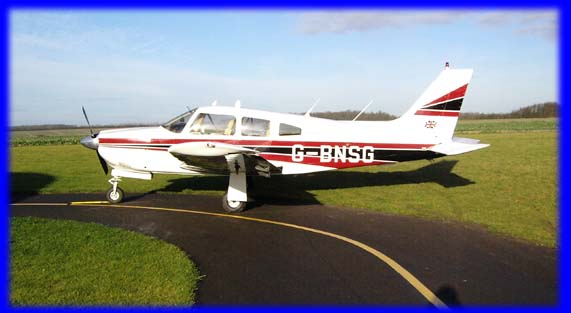 |
The Piper PA28R Cherokee Arrow is basically
just a Cherokee 180 with retractable undercarriage and a new wing of
markedly thicker section for it to retract into. Take-off
performance was sometimes `interesting', so later versions were
upgraded to 200hp engines. The wing later acquired the same `stretch
and taper' treatment as the parent Cherokee, but retaining the
Arrow's section. Also forst flying in 1960, the Arrow grosses
2,500lb, has a top spped of 165mph, cruising speed of 135mph and
range of 950 miles, Over 5,500 have been built so far. The type is
still in production (as at January 2006).
The example illustrated is the one David flew for
a while as part of the syndicate at Top Farm, where it was pictured
in 2004. I can attest to its being an extremely good touring
aircraft. |
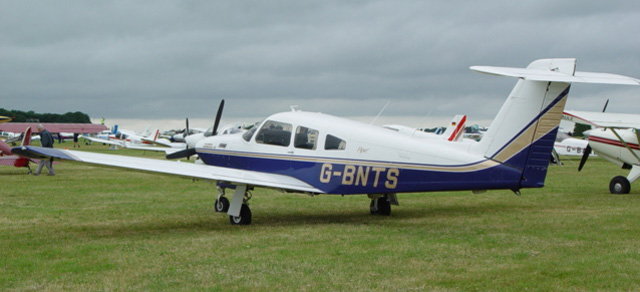 |
The Piper PA28RT Arrow IV first flew in 1979,
and illustrates the fad for the time of putting T-tails on many
models of light aircraft. (Piper, Grumman and Robin were
particularly prone to this disease, and even Beech succumbed for a
few models). Powered by a 200hp Continental TSIO-360 engine,
it is slightly bigger than the Arrow III, being 27 feet 3 inches
long with wing span of 35 feet 5 inches. Gross weight is higher at
2,900lb, but much of this is the strengthened tail structure. It is
faster: top speed is 195mph. Only 500 were built before the type was
discontinued in favour of the Arrow III, which retained the low set
tail. This one was at Kemble in July
2005. |
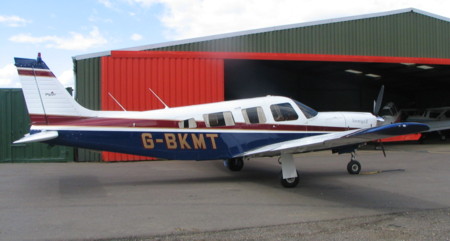 |
The Piper PA32 Cherokee Six is basically just
a Cherokee with the fuselage stretched to accommodate six people,
and equipped with a larger (six cylinder) 260hp Lycoming O-540
engine. The engine was quickly upgraded to a 300hp IO-540, which
gives it pretty good performance. (It feels like flying a souped-up
Arrow). It first flew in December 1963. Amazingly, it took until
1977 to produce a retractable undercarriage version, called the
Lance. At about the same time the increased span (36 feet 2 inches
versus 32 feet 10) and tapered outer section wing was introduced, as
on the PA28, and a new, refined version produced called the
Saratoga. Length of all models is 27 feet. Gross weigth is 3,600lb
and payload 1,500lb. The Lance cruises at 150mph and has a range of
950 miles. Over 7,800 have been built to date, of which about 3,400
have retractable undercarriage; it remains in production.
This Saratoga was visiting Top Farm in July
2007.. |
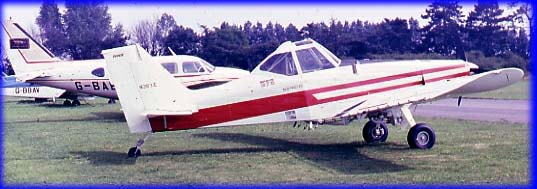 |
The Piper PA36 Pawnee Brave looks
superficially like the PA25, but is largely a new airframe
incorporating the results of an extensive survey of PA25 operators.
It is bigger: 27 feet 6 inches long and with 38 feet 10 inch wing
span. It is heavier: gross weight is 4,800lb, with 2,240lb of
payload. (That's almost as much as the total weight of a fully
loaded Cherokee). Hauling all this aloft is an engine ranging from
285 to 400hp. It first flew in November 1969. About 925 were built.
This one was at Kidlington in July 1978. |
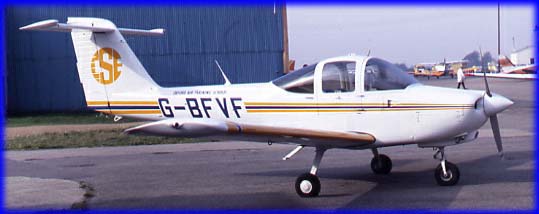 |
The Piper PA38 Tomahawk was the company's
1977 new entrant to the light trainer market, until then dominated
by the Cessna 150 / 152. Powered by a 112hp Lycoming O-235 engine,
its most obvious feature is the `bubble' canopy which (I can attest,
having done my initial flying training in one) gives excellent
visibility. It is very forgiving (perhaps too much so for a
trainer), and straightforward. It is 23'1" long, wing span is 34',
gross weight 1,670lb, top speed 120mph, and range is a useful 500
miles (the real benefit of this is the ability to fly several
successive training flights without having to stop to refuel).
Around 2,500 were built before production was halted by the
catastrophic recession in the US light aircraft industry in the
early 1980s. This one was at Kidlington
in July 1978. |
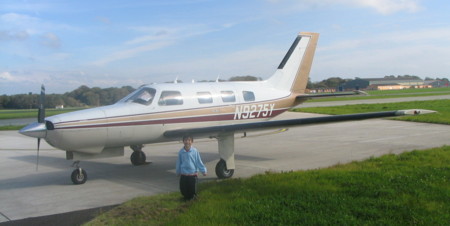 |
When Piper introduced the PA46 Malibu in
1979, it was an entirely new category of aircraft, being a cabin
class pressurised single engined aircraft. Powered by either a 310hp
Continental TSIO-520 of 350hp Lycoming TIO-540 engine, it has a
cruising speed of 215mph, top speed of 260mph and range of 1,700
miles. It normally seats five (the pilot plus four in the cabin). It
is 28 feet 5 inches long with a wing span of 43 feet. Gross weight
is 4,100lb for the 310 and 4,300lb for the 350. Over 1,00 have been
built up to January 2006: the type is still in production.
This one was at Haverfordwest in September 2007. |
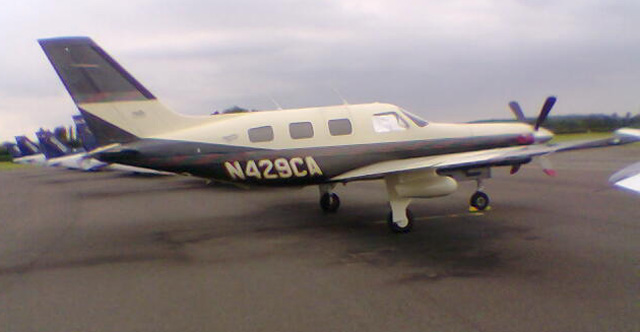 |
The Piper PA46 Malibu Meridian was introduced
in August 1998 as a turboprop version of the Malibu (the piston
version being renamed the Mirage). Power is given by a Pratt &
Whitney Canada PT6A turboprop of 500shp, which increases cruising
speed to 290mph, seating to 6, and length to 29 feet 7 inches, but
its higher fuel consumption reduces range to a (still very useful)
1,100 miles. Over 210 had been built by January 2006; it is still in
production.
This one was photographed by Ivy at Kidlington in
2004. |





|